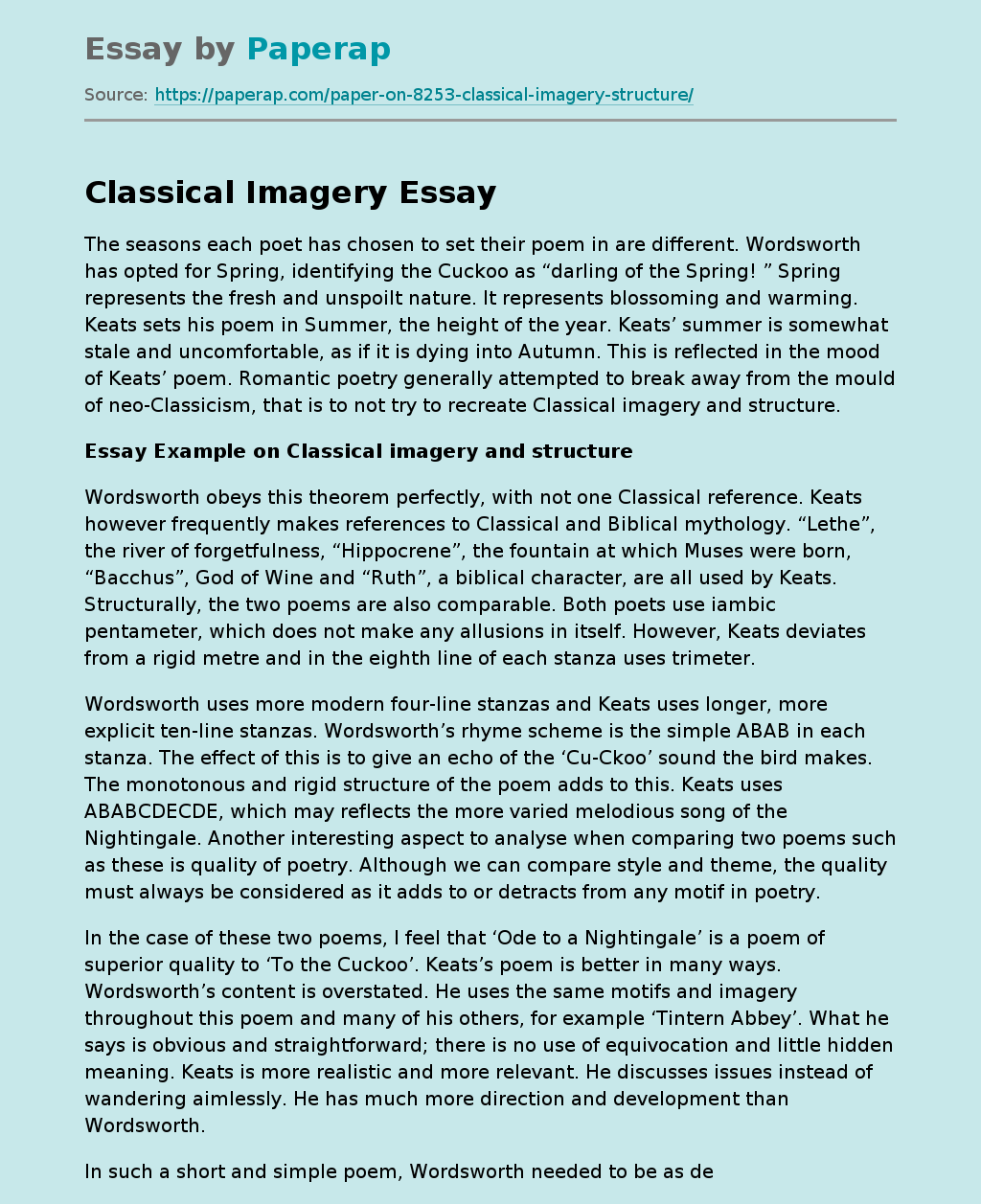Classical Imagery
The seasons each poet has chosen to set their poem in are different. Wordsworth has opted for Spring, identifying the Cuckoo as “darling of the Spring! ” Spring represents the fresh and unspoilt nature. It represents blossoming and warming. Keats sets his poem in Summer, the height of the year. Keats’ summer is somewhat stale and uncomfortable, as if it is dying into Autumn. This is reflected in the mood of Keats’ poem. Romantic poetry generally attempted to break away from the mould of neo-Classicism, that is to not try to recreate Classical imagery and structure.
Essay Example on Classical imagery and structure
Wordsworth obeys this theorem perfectly, with not one Classical reference. Keats however frequently makes references to Classical and Biblical mythology. “Lethe”, the river of forgetfulness, “Hippocrene”, the fountain at which Muses were born, “Bacchus”, God of Wine and “Ruth”, a biblical character, are all used by Keats. Structurally, the two poems are also comparable. Both poets use iambic pentameter, which does not make any allusions in itself.
However, Keats deviates from a rigid metre and in the eighth line of each stanza uses trimeter.
Wordsworth uses more modern four-line stanzas and Keats uses longer, more explicit ten-line stanzas. Wordsworth’s rhyme scheme is the simple ABAB in each stanza. The effect of this is to give an echo of the ‘Cu-Ckoo’ sound the bird makes. The monotonous and rigid structure of the poem adds to this. Keats uses ABABCDECDE, which may reflects the more varied melodious song of the Nightingale.
Another interesting aspect to analyse when comparing two poems such as these is quality of poetry. Although we can compare style and theme, the quality must always be considered as it adds to or detracts from any motif in poetry.
In the case of these two poems, I feel that ‘Ode to a Nightingale’ is a poem of superior quality to ‘To the Cuckoo’. Keats’s poem is better in many ways. Wordsworth’s content is overstated. He uses the same motifs and imagery throughout this poem and many of his others, for example ‘Tintern Abbey’. What he says is obvious and straightforward; there is no use of equivocation and little hidden meaning. Keats is more realistic and more relevant. He discusses issues instead of wandering aimlessly. He has much more direction and development than Wordsworth.
In such a short and simple poem, Wordsworth needed to be as deep-meaning as possible and explore his subject matter as much as he could. Keats’ structure too is far more impressive than Wordsworth’s. Wordsworth is too simple in his language, structure and rhyme. His poem is neither fired up nor passionate. His poem comes across as vague and verbose, using tawdry expressions and clichi?? s such as “Still long’d for, never seen! ” He does not display his intellect and the result is he does not write to his capacity.
Keats carries on for eighty lines in comparison to Wordsworth’s thirty-two, but not once does he lose his drive or allow a lapse in quality. He exhibits his ability to rhyme and narrate. He displays contextual knowledge of Europe and Classical mythology and uses it effectively to create imagery and effect. As I feel that one poem is better than the other, this contributes to any comparison, and makes direct comparison more difficult if the poems are on different levels. In a better poem, the meaning and desired effect is received effortlessly by the reader and the reader is much more appreciative of the author’s style and themes.
Classical Imagery. (2019, Nov 27). Retrieved from https://paperap.com/paper-on-8253-classical-imagery-structure/

